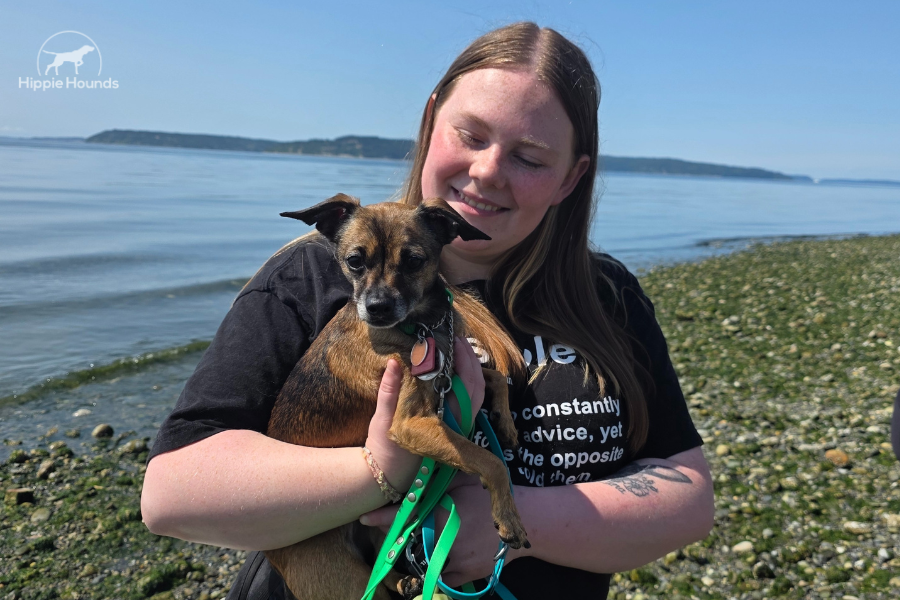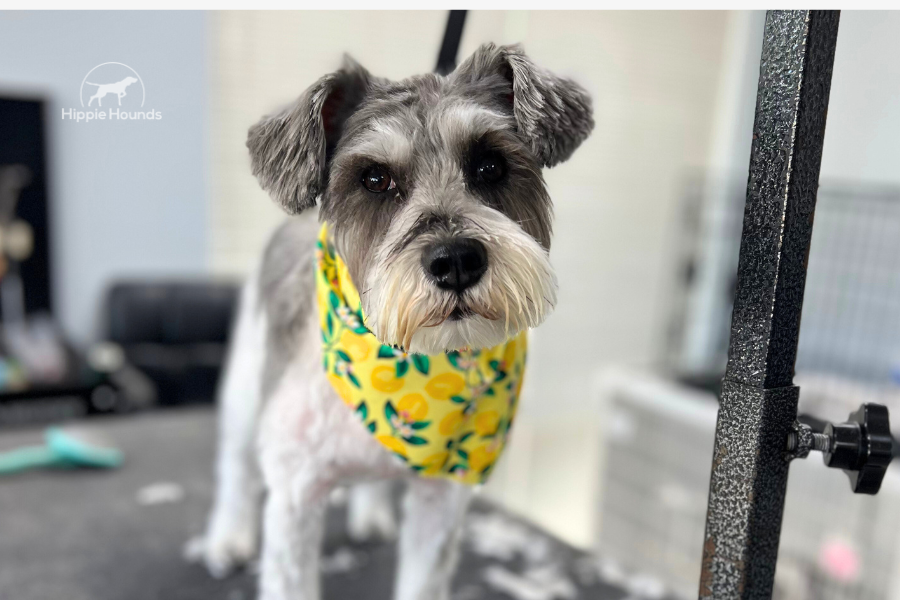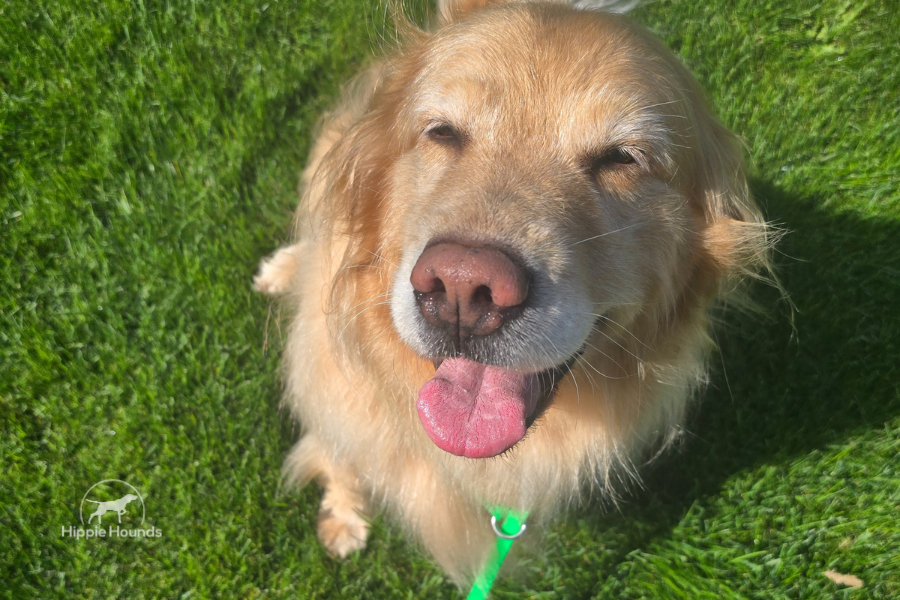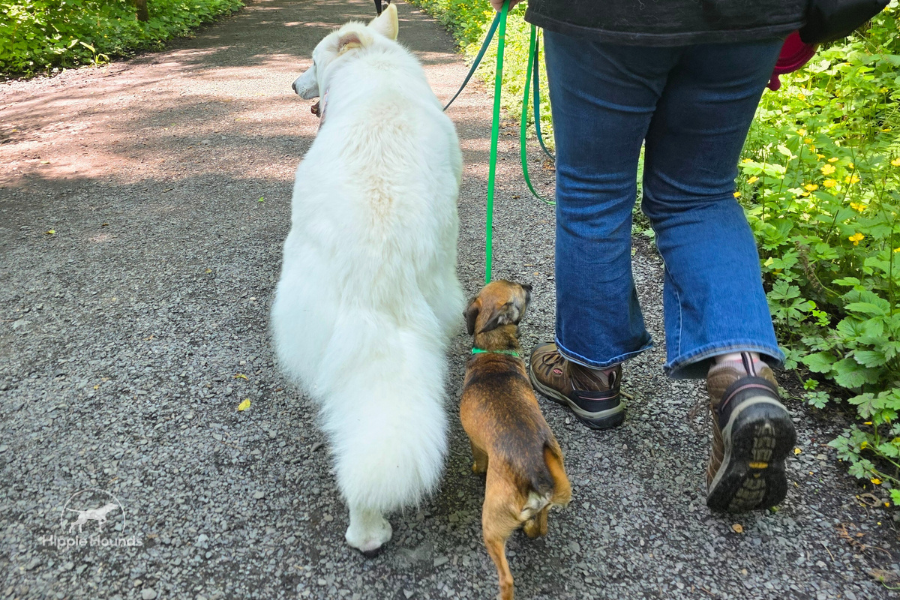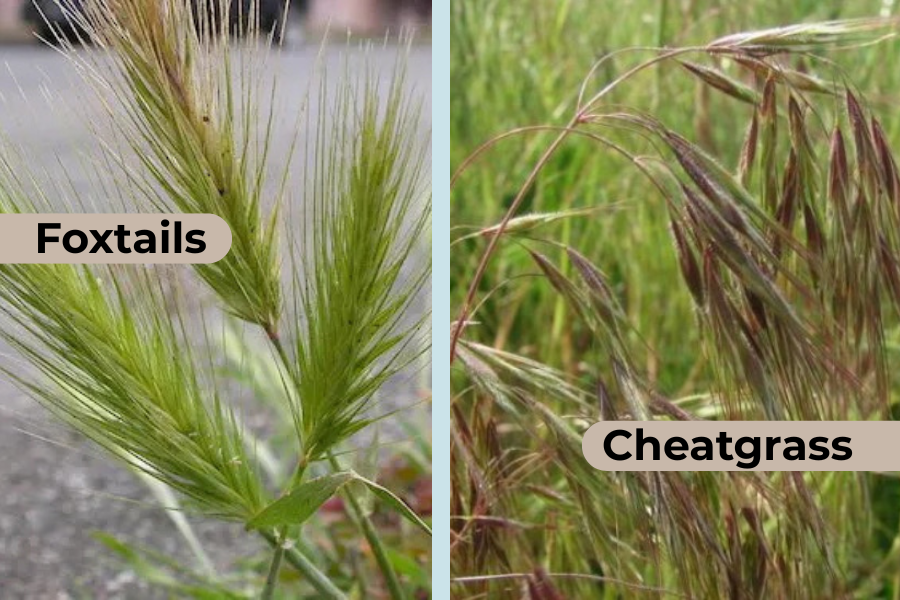Summer Care Tips for Dogs
How to Turn Your Hot Dog into a Cool Cat!
By Hippie Hounds Grooming • June 19, 2025
The time of year we’ve all been waiting for is finally upon us … SUMMER! Although we all love the warm weather and its activities, this season brings a long list of potential hazards to your dog that shouldn’t go overlooked. But don’t worry, we have you covered with our expert summer care tips for dogs!
From cracked paw pads and sunburns to environmental issues like insects and plants, there’s a lot to watch out for to keep your dog as healthy and safe as possible this summer.
Bather Sylvia and her pup Joker enjoy some sunshine at Meadowdale Beach Park.
Keeping Your Dog Cool in the Summer
Watching for signs of our furbabies overheating in warmer weather is undoubtedly a concern as pet parents. A nice warm summer day is divine to most of us, but to our canine friends, it can be potentially lethal.

Summer Care Tip: Keeping cool, fresh water available at all times is critical for your dog’s safety in hotter temperatures.
Your Dog’s Anatomy: Temperature Regulation
Did you know that on average, a dog’s body temperature runs around 101 to 102 degrees Fahrenheit?
You could imagine how excessive heat can quickly have an effect on them with a naturally higher body temperature. All breeds of dogs (and almost every mammal, including humans!) have something called the arrector pili muscle that controls the hair follicle. It allows a dog’s coat to lift away from the skin and tuck in tightly to the skin for thermoregulation.

Summer Care Tip: Properly and regularly grooming your dog can mean the difference between him being able to self-regulate during hotter weather or not.
Grooming Your Dog in the Summer
All breeds benefit from being fully combed out, and some need de-shedding. Why is that?
Sunday the Schnauzer after her ready-for-summer haircut
For dogs that shed, it is important to keep them re-moisturized and to pull out the dead coat. For non-shedding type breeds, re-moisturizing and removal of mats and tangles is most important.
This maintenance allows both coat types to function properly for temperature regulation.

Summer Care Tip: Maintaining a Coat that Sheds
It seems counterintuitive, but shaggy shedding dogs NEED their full coat to keep cool. The importance should be placed on the removal of mats, tangles, and compacted dead undercoat. A shorter belly clip at the groomers can also help cool your dog down, as they can lie down directly on colder surfaces, such as the kitchen floor or hardwoods.
Summer Care Tip: Maintaining a Coat that does NOT Shed
Other breeds that don’t shed would benefit from their hair being cleaned, re-moisturized, and fully combed out. Oftentimes, pet parents will want to shave dogs down, thinking it will help pups to maintain their temperature, but this isn’t always the case. A little bit of fur left all over and being mat-free gives the dog the best chance of self-regulation. Taking dogs too short in the summer can also lead to a lack of UV protection.
Preventing Your Dog from Overheating
Some breeds are more prone to overheating, particularly if they are brachycephalic. Brachycephalic breeds are any dog that has a “smashed” face or shorter in the nose — and sometimes their nose doesn’t need to be visibly short to be considered “brachy” (like an English Mastiff or Chihuahua, for example).
Trixie is ready to cool off after catching some rays
The simple act of planning ahead and being prepared could mean avoiding a traumatic experience with your furbaby.
- Try to avoid walking your dog in the hottest parts of the day and save the longer walks for early morning or after the sun has gone down.
- Never leave your dog in the car on warm days, as the temperatures inside the car increase rapidly.
- Make sure your pet always has access to cool drinking water, and keep a shady area available to them, even when out on walks.

Summer Care Tip: For greater chances of avoiding your dog overheating, especially if they are brachycephalic, make sure you always carry fresh drinking water and a spray bottle with water. You might consider purchasing a cooling vest or cooling towel to keep with you as well.
Signs Your Dog is Overheated
It is important to know what to do if your dog starts to experience signs of overheating. If possible, immediately get them into a cooler environment, like an air-conditioned home or shaded area.
Signs of pet heat stroke or overheating are:
- Excessive panting and drooling;
- Increased heart rate and rapid breathing;
- Acting more lethargic or disoriented;
- Vomiting or diarrhea; and/or
- Fully collapsing.
If your dog is experiencing signs of overheating, help them to safely regulate their temperature by:
- Splashing regular tap-cold water onto them slowly until they start to cool down;
- Using a fan to direct airflow onto them;
- Lying them on top of a cold, wet towel — don’t place towels directly on your dog, as this traps body heat and can warm them up even more;
- Having water nearby for when they can drink again; and
- Staying calm yourself to help lower their heart rate.
Keeping Your Dog Safe from Summer Hazards
Hot concrete isn’t the only environmental hazard to your dog when going outside this time of year. Different climates and landscapes will come with varying threats to your dog, so it’s a good idea to brush up on your area’s specific hazards. Knowing how to prevent your dog from harm and recognize disconcerting signs can greatly impact his health and longevity.
Hulk and Joker in a pocket of shade during their walk at Meadowdale Beach Park.
Protecting Your Dog from the Sun
Just like us humans, your dog can get sunburnt without taking precautions. Sunburns can happen fast and will frequently occur on the tips of his ears, the less hairy places on his head and muzzle, around his eyes, the bridge of his nose, and even on his belly and undersides from the sun reflecting up onto him.
Many dogs love to sunbathe, and all dogs instinctively know when to get out of the sun, so it is important to always have a place of shade for them to run to. If you’re taking your dog on a family outing at the beach or a picnic, consider bringing a covered kennel or a big beach umbrella they can run under if they need to.

Summer Care Tip: Over-the-counter dog sunscreens can be used to avoid sunburn (like this one by Divine Canine). Keep in mind the time of day and how powerful the sun is when your dog is outside. For sensitive pets, it is usually a good idea to avoid taking them out in the hottest parts of the day entirely.
Knowing When Your Dog Has Sunburn
The signs of sunburn can vary from pet to pet, but you’re mostly watching out for red or pink skin that can be sore or sensitive to the touch, cracked or dry tips of their ears, rashes or sores, and even hair loss in the burned areas.
If the burn is severe enough or your pet is in pain, you may need to seek emergency veterinary care. A doctor can prescribe medicated lotions and/or creams, some of which even include pain relief.

Summer Care Tip: If your dog does experience sunburn, the best thing to do is put a cooler, wet towel on the affected areas (if they let you!) or rub aloe vera on the affected areas.
Preventing Paw Pad Burns
Hot, walkable surfaces pose another risk of pain to your pooch. A dog’s paw pads can burn in as little as one minute, and it is very painful. It is not normal for your dog to have cracks in their paw pads. This can be a sign of being burned (but could also be other health issues, too).
Dogs will chew on their feet, lick their paws, limp, and potentially even cry or vocalize their pain. If your dog suddenly stops in the middle of a walk, it is a good idea to check their feet immediately and get them to a grassy or dirt surface.
Paw pad burns happen in varying degrees, so please contact your vet if your dog has displayed any signs of pain or discomfort after a hot walk.

Summer Care Tip: Before allowing your dog to run outside onto hot concrete or asphalt, place the back of your hand firmly onto the ground and hold for seven seconds. If you experience any discomfort, it is not safe to walk your dog on that surface.
Plant Hazards to Your Dog
Here in Washington state, we have a particularly nasty weed called Foxtails, which can cause potentially life-threatening infections if they are not found and removed from your pet quickly.
Cheatgrass is another plant that functions similarly to Foxtails in that the barbed seeds burrow deeper once they penetrate the skin. Knowing what these plants look like is critical, as they are very common all over the Pacific Northwest.
Foxtails and Cheatgrass: Know what to look out for
Another thing to watch for in yards and grassy areas is sap or pitch from trees that can stick onto your dog’s feet or skin and give them irritation as well. We always recommend using coconut oil to gently remove any sap that we are not able to shave out during a groom. Sometimes, the sap needs to be left alone until the hair grows out long enough for a clipper blade to safely glide underneath.

Summer Care Tips:
-
Avoid taking your dog into tall grass, and watch out for sap or pitch from trees that can stick to their feet and cause irritation.
-
Give your dog a thorough inspection after taking her outside, especially paying attention to the tiny nooks and crannies between her toes.
-
Use coconut oil to gently remove sap and other stubborn substances from your dog.
Safe Pest Management for Your Dog
Fleas, ticks, and mosquitoes are at an all-time high in the summer, too. The best flea/tick/worm preventatives are always found at the veterinarian. Speak with your vet about the best plan to prevent your dog from suffering from insect-borne diseases.
Be wary of walking your dog through tall grass, and ALWAYS check them over at home for ticks (while checking for foxtails, too!). Ticks like to hide between a dog’s toes, along lip lines, and especially on their ears, but we have seen ticks on every part of dogs’ bodies. Without intervention, ticks can lead to Lyme disease and tick paralysis, among other long-lasting issues.
When your dog is well-groomed, you’ll be able to find pests or bug bites more easily.

Summer Care Tip: Avoid using over-the-counter flea medication, as fleas have built up a tolerance to these products after decades of use. In addition, keep your pets away from stagnant water, as mosquitoes love to lay their larvae there. (Mosquitoes can lead to your dog developing heartworms, requiring veterinary care and potentially altering their life forever.)
The Tail End
In conclusion, summertime is great for adventuring with your beloved dog, and doing so safely with her health in mind will increase your bond with her even more. Remember that you are the caretaker, and it is important to fully understand simple first aid and incident prevention to better care for your precious furbaby.


